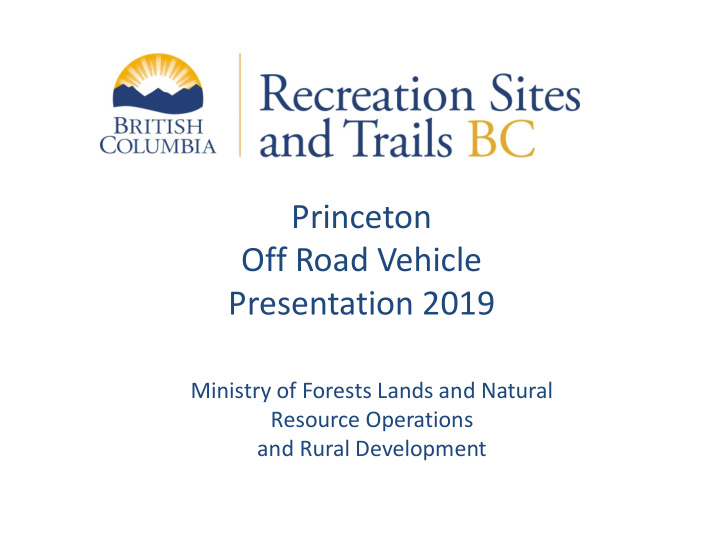



Princeton Off Road Vehicle Presentation 2019 Ministry of Forests Lands and Natural Resource Operations and Rural Development
Program Mandate 1. Develop, manage and promote a network of designated recreation sites and trails 2. In collaboration with other Natural Resource Sector business lines, manage public recreation use and protect recreation resources on Crown land outside designated recreation sites and trails . 3. Authorizing construction of recreation facilities and trails on Crown land
RSTBC Program Message We support sustainable public recreation development according to the Trails Strategy for BC, local needs and priorities for land and resource management. Where groups have trail construction or maintenance initiatives they would like to pursue RSTBC would invite them to make application through front counter BC. Where ORV groups require financial support or guidance we would recommend they consider the ORV Trail Fund (established by government in 2017), their local district recreation officer and their provincial organization including the BC Snowmobile Federation, the BC Off-Road Motorcycle Association or ATV-BC.
Program Assets 1352 Recreation Sites 550 Recreation Trails (+10,000 km) Recreation sites and trails receive over 2 million visitors per year.
4 Recreation Regions
49 Program Staff Director Recreation Administrator 4 Regional Manager, Manager, Managers Recreation Trails Geomatics District Recreation Trails Specialist Technician Officers Recreation Technicians • 49 recreation staff are located in district offices. (2 recreation staff in the Cascades (1 DRO & 1R-Tech) • 7 are located in regional offices and at headquarters in Victoria .
Program Budget 3 Funding Sources: 1. $ 6.8 million – Operational Funding (50% salary) 2. $ 1.4 million – Capital Infrastructure Fund 3. $ 0.65 million – Land Base Investment Strategy Fund Total Program Budget - $8, 850,000 EXPENDITURES $5,450,000 Operational est. $1.362,500 est. (divided by 4 Regions) $150,000 (Cascades Natural Resource District) 173 Sites and Trails (Princeton to Goldbridge) 50% allocated for Maintenance Contracts $750/log table $1,500/pit toilet $350/fire ring Danger Tree assessment & falling $1,000 to $1,500 Septic Service Ect ….
Recreation Site and Trail Operations Partnership Approach There are currently over 300 partnership agreements for managing 373 recreation sites and 200 recreation trails. Partners include: • First Nations bands, • community groups, • outdoor recreation organizations, • forest companies & industry, • regional districts, • municipal government ▪ Partners contribute 46 person years worth of work annually. ▪ On average, $2.0 M in user fees are collected annually, to off-set management costs.
Capital Improvement Program A Capital improvement program was introduced in 1971 to upgrade recreation sites and trails in order to keep them open to the public. More than 250 capital investment projects amounting to more than $20 M have been completed. Capital funding is used by RSTBC staff and partners to leverage significant 3 rd party funding.
Legislation Forest and Range Practices Act Part 5, Division 3 Recreation Section 56 - Establish a Recreation Site, Recreation Trail or Interpretive forest (Government Process) Section 57 – Authorize construction, rehabilitation or maintenance of a trail or other recreation facility (Application) Section 58 – Restrict or prohibit recreation use of Crown land Forest Recreation Regulation – applies to sites and trails designated under Section 56
Major Initiatives Trails Strategy for British Columbia A multi-agency and stakeholder, collaborative approach to developing and managing a world- renowned network of trails. Provincial Trails Advisory Body – leading implementation of the Strategy
Major Initiatives Trails Strategy for British Columbia The Trails Strategy provides the framework, principles, and guidance necessary to develop a world class trails system for BC. Overall, this framework establishes clear strategic direction for planning, developing, maintaining, managing, marketing and using an integrated network of trails in our province over the next 10 years. COLLABERATIVE PLANNING ensures trails have the broadest level of community support and are responsive to the needs of all interests. Collaborative planning must include engagement with First Nations, other resource users, all levels of government, and trail user groups. Action #3: Collaboratively develop local, regional and provincial trail system plans that secure opportunities for all trail users in balance with environmental, cultural and social values. Implementing this action will require a comprehensive review of local and regional trail planning processes, researching the best collaborative practices available, and then applying the learning to ongoing planning processes.
Major Initiatives BC Rail Trails Former rail corridors, acquired by the province for conversion to recreation trails. • Kettle Valley Rail Trail – 420 km • Columbia and Western Rail Trail – 160 km • Slocan Valley Rail Trail – 50 km KVR and C&W constitute 580 km of BC’s Trans Canada Trail
Program Challenges Increasing demand for recreation opportunities • often as a component of rural economic development strategies Use conflict • public versus commercial • motorized versus non-motorized • resource conflict Access Management Planning • growing demand for recreation access management planning • currently no framework or resource support
Rural Development Challenges Local Governments Build it and they will come • Be prepared to manage the impacts • Be prepared to support the groups that are supporting the tourism industry in your area. Properly built and sustainable trails will heighten your tourism potential. Poorly built and non-sustainable trails will be detrimental to your tourism draw.
Action Items 1. Be involved • Manage YOUR sport (FRPA s 57 application) • (i.e., VARDA, Coq Snow Club) • Prov/local Gov plans • Stakeholder/User Group Planning 2. Funding • ORV Fund • Private entities (O/G, local supporters) 3. First Nations Reconciliation • Talk and engage with the local Indian Bands • Economic opportunities and government funding 4. Healthy life choices 5. Employment • Trail builders, Summer Youth, First Nations reconciliation 6. Tourism • Local benefits (hotels, restaurants, ORV dealers, small engine repair, vendors, campgrounds,) 7. Be responsible LAND STEWARDS of YOUR sport 8. SAFETY! Wear your Helmet, Register your vehicle and have Insurance.
Recommend
More recommend